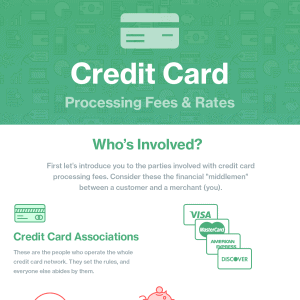Chargebacks are one of the costs of doing business, but you can minimize your risk by communicating well with customers and keeping good records.
Our content reflects the editorial opinions of our experts. While our site makes money through
referral partnerships, we only partner with companies that meet our standards for quality, as outlined in our independent
rating and scoring system.
Dealing with chargebacks is one of the most frustrating parts of running a business. While most merchants only face them occasionally, a high chargeback rate can classify your business as high-risk or even lead to account freezes.
We can’t make your business completely chargeback-proof, but we can help you minimize their frequency and give practical tips for handling them when they happen.
If your current processor isn’t helping you manage chargebacks effectively, it might be worth considering a switch to a provider better suited for your needs.
Why Small Businesses Need To Prevent Chargebacks
A chargeback happens when a customer goes straight to their bank to get a refund instead of returning the item to you. There are a few reasons your business may have a chargeback:
| Reason for Chargeback |
What It Means |
Example |
| Clerical error |
Honest mistakes |
Double-charging a customer |
| Customer dissatisfaction |
Customer unhappy with product/service |
Product didn’t match description |
| Fraud |
Dishonest or opportunistic behavior |
Customer files chargeback after using the product |
Chargebacks are different from returns. Returns go through your business and are simple to handle. Chargebacks involve banks and card networks and can even apply to ACH or eCheck payments.
Chargebacks can hurt your business in several ways:
- You have to refund the customer.
- You usually pay a chargeback fee ($15–$25 per case), even if the chargeback is resolved in your favor
- They’re time-consuming and stressful
- Fewer than 20% of chargebacks are resolved in favor of the merchant.
Chargeback policies are designed to protect consumers, not merchants. Prevention is far easier than dealing with disputes after the fact.
Essential Tips To Avoid Chargebacks
Even though the odds are stacked against merchants in chargeback disputes, you can reduce your risk by being proactive. Here’s how:
Communicate With Customers
Open communication can prevent misunderstandings. Make your refund and return policies clear — on your website, in-store, and at checkout — so customers know what to expect before purchasing.
Describe Products & Services Clearly
Provide accurate, detailed product descriptions. This is especially important for online sales, where customers can’t see items in person.
Offer Excellent Customer Service
Make it easy for customers to contact you by phone or email. Respond quickly to inquiries to prevent frustration and potential chargebacks.
Set Clear Return Policies
A simple, fair return policy reduces the chance of disputes. Define timelines, restocking fees, and procedures so customers know exactly how returns are handled.
Check Card Expiration Dates
Never accept expired cards. Most terminals detect them automatically, but double-check as a backup. Train staff to do the same.
Get Signatures For Magstripe-Only Cards
Chip cards have replaced signatures, but magstripe-only cards still require a signature. Keep this in mind until magstripes are fully phased out.
Provide Contact Info
Include your business contact details on receipts or your website so customers can resolve issues directly instead of filing a chargeback.
Optimize Your Billing Descriptor
Make sure your business name appears clearly on the customer’s statement. Confusing descriptors can lead to unnecessary chargebacks.
Keep Detailed Transaction Records
Maintain clean, legible receipts. In disputes, documentation can prove that a transaction was valid and help defend against fraudulent chargebacks.
Save Receipts
Chargeback windows vary (180 days to 3 years). Keep receipts organized so you can respond quickly if a dispute arises.
Set Clear Shipping Expectations
Communicate shipping times and provide tracking or proof of delivery. This prevents disputes for “items not received” or delayed shipments.
Follow Card Processing Protocols
Make sure to follow basic card processing protocols:
- Don’t swipe or enter a card multiple times if authorization fails.
- Record authorization codes, dates, and amounts.
- Don’t estimate transaction amounts.
- Avoid duplicate transactions by voiding before reprocessing.
- Deposit receipts promptly.
- Use the Address Verification System (AVS) when necessary.
- Collect card verification codes for card-not-present transactions.
How To Fight Chargebacks
Understanding the chargeback process is key to protecting your business. Every dispute goes through a series of steps before a final decision is made. Knowing what happens at each stage—and what you can do to respond—can improve your chances of successfully contesting a chargeback.
| Action |
Description |
Notes |
| Initial Filing |
The customer contacts their bank to request a refund, starting the chargeback. |
This is usually triggered by dissatisfaction, clerical errors, or suspected fraud. |
| Initial Review |
The bank reviews the claim and assigns a reason code for the chargeback. |
Reason codes indicate why the customer is disputing the transaction. |
| Investigation |
The bank investigates the situation and decides if the claim is valid. |
If valid, funds are removed from your account. If not, the chargeback is voided. This decision is not final. |
| Processor Review |
Your payment processor reviews the chargeback on your behalf. |
They may reject it if you provide proof, or pass it to you and charge the standard fee. |
| Merchant Review |
You submit additional evidence to challenge the chargeback. |
Often the first time you see full details of the dispute. |
| Re-Presentment |
The processor resubmits the chargeback with your evidence. |
This step gives you another chance to defend your transaction. |
| Final Decision |
The bank makes the final ruling. |
Funds are returned if the chargeback is invalid, but processors usually don’t refund the investigation fee even if you win. |
Be Proactive To Prevent Chargebacks
Nobody likes chargebacks, but they exist for a reason: to protect customers. They push businesses to be honest, have clear return policies, and sell quality products. Online merchants especially need to be careful since customers can’t see or touch items before buying.
Unfortunately, some customers take advantage of the system. “Friendly fraud” is on the rise, and the current chargeback process doesn’t always catch it. The good news is you can be proactive to prevent getting burned by chargebacks.
The best way to fight chargebacks is to prevent them. Follow the steps we outlined earlier, keep the lines of communication open, and encourage customers to reach out to you before contacting their bank.
Some chargebacks are unavoidable, but you can minimize them. Many processors offer software-based chargeback protection programs that make disputes easier to manage and can save you money. For most small businesses, these programs are worth checking out.
Want to dive deeper? Our full guide to chargeback management covers the best programs and strategies to keep your business protected.











